Day three (October 2)
In the morning, we took off in a caravan of SUVs,
bound for Kharakhoram, the capital of the Mongol Empire between 1235 and
1260. This was a two night trip: drive southwest from
Ulaanbaatar to Kharakhoram, sleep in ger camp that evening, visit
Kharakhoram and the Erdene Zuu Monastery (which is the only part of
Kharakhoram still standing) the next day, then sleep in the gers again,
and return the following day.
The drive turned out to be about six hours, one hour of which was
fighting our way out of the ever-present Ulaanbaatar traffic. But along
the way, we stopped off to see a shrine next to an Ovoo, had a chance to
see the unending plains of the steppes, found that one of the most
amazing features of Mongolia is a complete lack of fences, ran into
traffic stops caused by herds of sheep, horses, and cow sleeping
on/crossing the road, passed by a number of colorful, tiny towns, took
the opportunity to wander around some sand dunes that appeared out of
nowhere, and saw many, many, many – did we say many? -
dead/decomposing/skeletonized animals.
 A roadside Shrine |
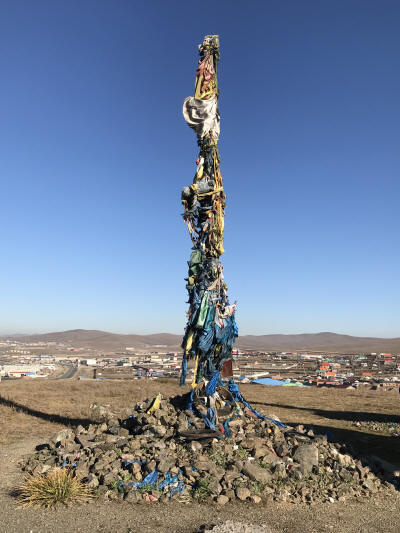 An Ovoo; people tie scarves to it for good luck |
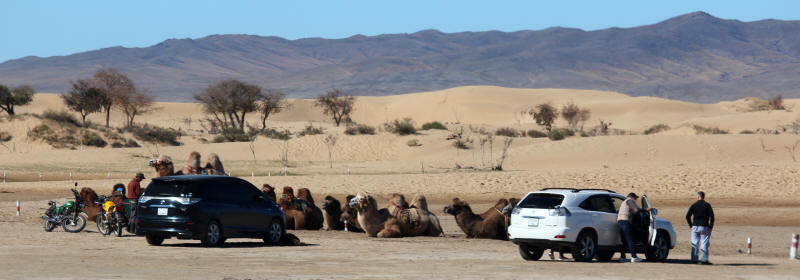 Can't have sand dunes without camels |
 Micro-town |
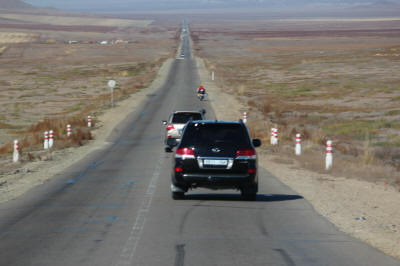 A whole lotta empty steppe |
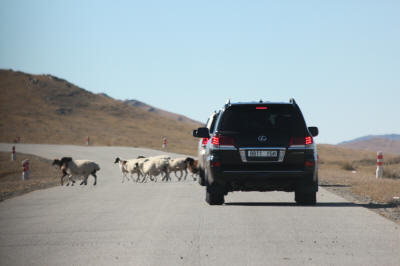 Traffic Jam |
When we reached Kharakhoram, we off-roaded it on dirt tracks for something like a million miles to reach the site of our ger camp situated on a scenic hilltop overlooking a gorgeous valley, and ate a quick lunch.

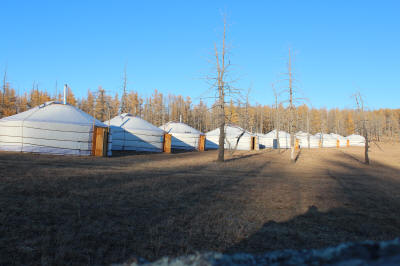 |
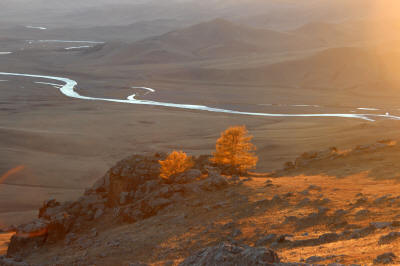 |
 Alison |
 Our group in the dinner Ger |
That afternoon, we returned to Kharakhoram and toured the Kharakhoram Museum. Chinggis Khaan is obviously the rock star of Mongolia, venerated for good reason by the entire country. But something else we were curious about came up. A thousand years before Chinggis were the Hunnu, the same general ethnic stock as the Mongols, and the one Hunnu everyone has heard of is Attila the Hun. While the Hunnu were described in some detail in the museum, there wasn’t a single mention of Attila. It is apparently unclear where he was from so perhaps the museum curators decided to keep the focus on Chinggis Khaan.
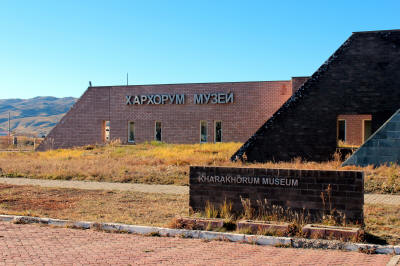 Kharakhoram Museum |
 A diorama of what Kharakhoram was like in it's prime |
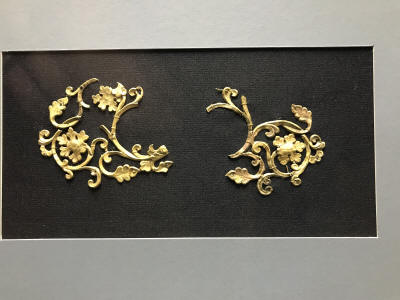 Some of the intricate gold jewelry found in the ruins of Kharakahorum |
 Part of the exhibit was items found in a buried tomb at Kharakhoram, including clay figures (117 in total) |
We returned to the ger camp after our excellent
museum visit. We had time to watch the sunset over the valley
after dinner and bliss out before we went to sleep in our ger.
Gers have a fairly standard basic structure although there are some
differences between the Kazakh ger seen in Western Mongolia and and the
eastern Mongolian version. Gers generally consist of a set of
wooden latticework panels that are tied together at the ends and linked
into a circle with a single low doorway between two sections,
specifically designed so no matter how you try not to you will hit your
head on on the door frame at least a couple of times a day. Each grid
that makes up a panel is constructed of thin strips of wood that are
connected to each other by a piece of knotted leather, so you can fold
them up like an accordion. You can vary the size of the ger by using
different numbers of panels; five or six are the most common. Then
poles are extended from each panel to a central, circular hoop overhead
that’s held up by two long poles, forming a sloping roof. The
entire framework is covered in heavy fabric, leaving an opening in the
top, and a wood stove is placed in the middle with a stove pipe through
the opening above. Throw down rugs or linoleum on the ground, add
furniture, and you have a cozy little living space. We didn’t
witness this, but our guide Ganzo told us an empty ger could be taken
apart in a half hour and reassembled in one hour. The entire ger,
including the furniture (which is designed to fold up) and stove could
be carried by two camels.
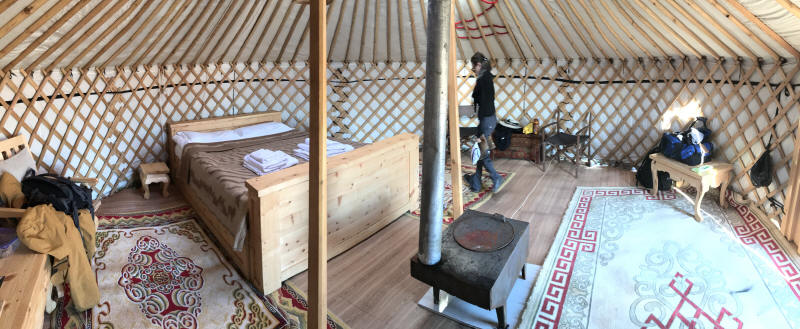 Our ger |
 Alison goes Zen |
 Sunset |
Camp attendants took care of the wood stove for
us which were stoked just a little before bed time and then again in the
early morning. It was a little odd having someone come into your
room every morning, but it was wonderful to have a cozy, warm living
space when you had to get out of your comfy bed with its cotton sheets
and cashmere blanket. There were “common area” gers for dining and
for the women’s and men’s bathrooms (with portable camp toilets and a
warm shower set up), and again, camp staff took care of all of the
cooking and other common area tasks. And the food was excellent!
It was so rough: there was no omelet station at the breakfast buffet,
no coffee maker in the ger, and no wifi, but we're badass Americans and
can handle adversity.
Day Four (October 3)
Before breakfast, we took a early morning walk around the camp, trying to find the best spot to see the sunrise. Some of the rock structures around the camp were interesting and whetted our appetite for a hike later in the day.
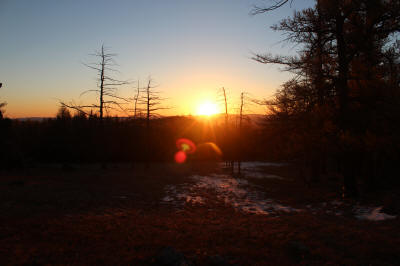 Sunrise |
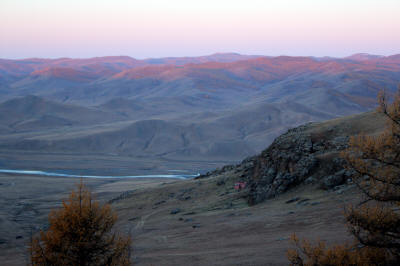 Morning light hitting the mountains |
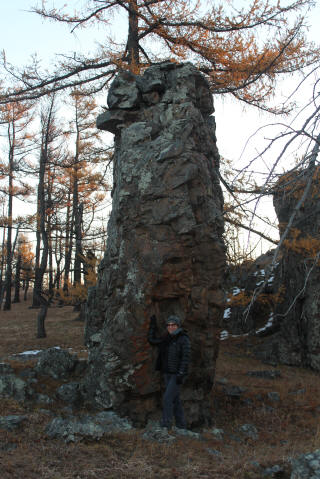 One of the odd geological formations around the campsite |
 Joe did a drawing of them, along with tree stumps from locals foraging for firewood |
After breakfast with our group, we headed down to the Erdene Zuu Monastery. In theory, we would see Kharakhoram as well, but it had been so completely obliterated that there was almost nothing other than the Monastery complex left from what had once been a vast city.

Erdene Zuu from a distance
On the way down, we stopped to see the penis
stone, a stone that is shaped like a … wait for it… penis, placed at the
point where two mountains come together in a way that is supposed to
look like something President Trump would like to grab. It was
originally placed there by a monk as a way to help the younger monks
overcome their more base urges (the logic behind this scheme escapes
us), but it has subsequently become a place that is supposed to increase
a women’s fertility, and many people come for just such a blessing.
 Locked and loaded, the penis stone |
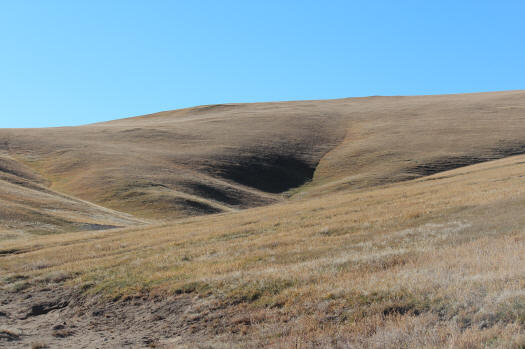 This is supposed to look like female anatomy... but we couldn't see it |
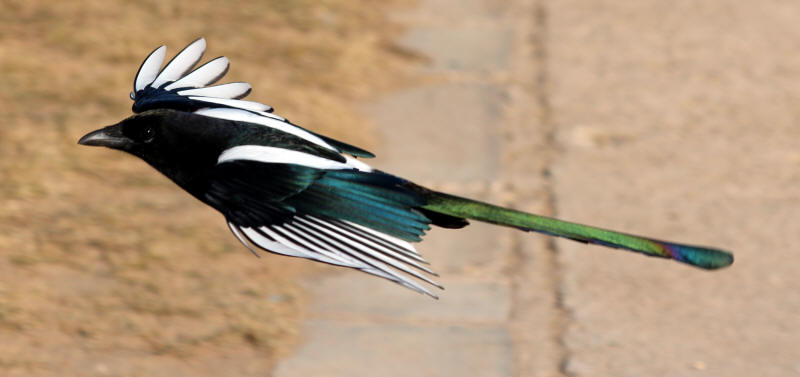
These cool magpies where hanging around the penis stone
We also stopped by an Ovoo where people had added a long line of cow skulls in addition to the more traditional scarves and bolts of cloth tied to it.
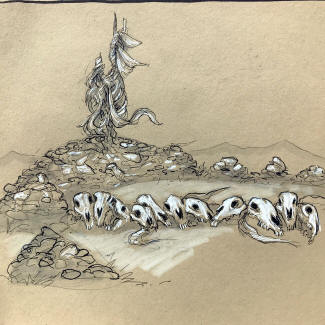 Joe's rendition |
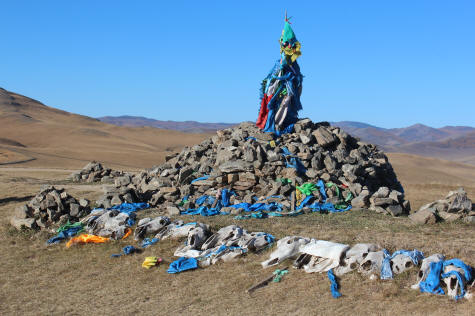 The real thing |
We could see the Monastery complex below as
we approached. The three buildings and walls left by the Russian purge
had been restored, and some of the other structures had been rebuilt,
but most of it was empty ground. Sometimes there was a platform that
had been the foundation of a building, or stones where buildings used to
stand, but mostly it was dirt and scrub.

The temples were fascinating, with the
equivalent of the gargoyles we’d seen on French cathedrals, intricate
stone and woodwork. One interesting fact: no nails were used in the
construction of the temples. The wood has intricate notches that allow
the beams and planks to be firmly locked together without glue or nail.
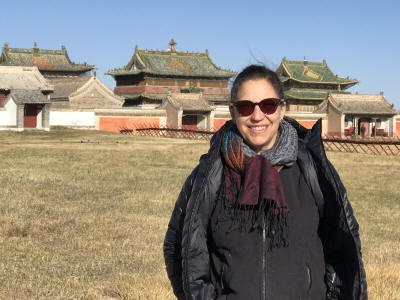 |
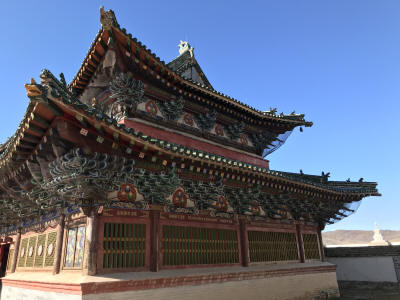 |
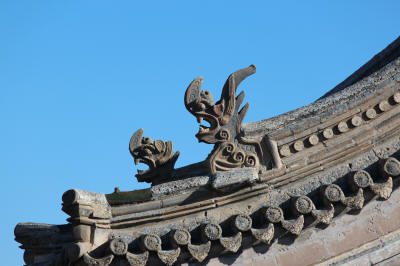 |
 |
The buildings contained a number of Buddhist artifacts that Ganzo went over in great detail – we wish we had recorded what he said!
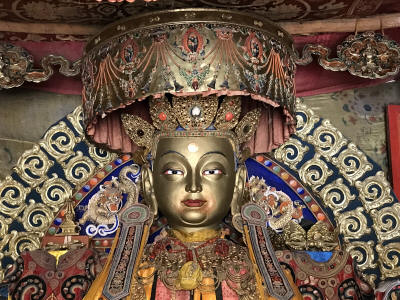 This complex is knows as the Land of 1000 Buddhas |
 Wonder wny? |
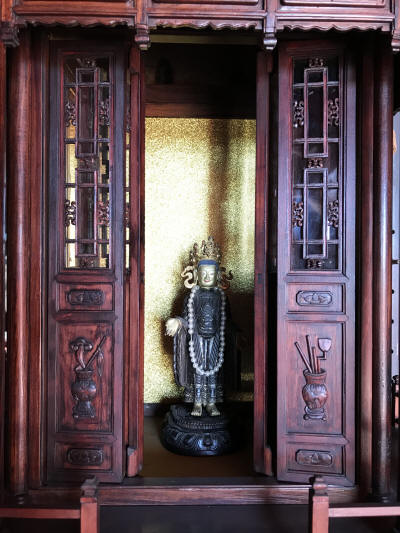 Buddha in a Tardis |
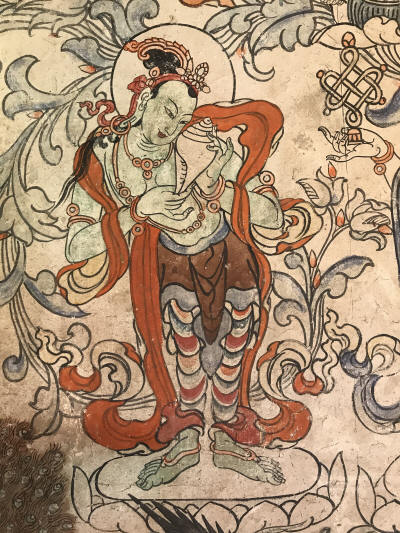 n Buddhism, a white conchthat coils to the right represents the sound of the Dharma reaching far and wide, awakening beings from ignorance |
 From the 18th century |
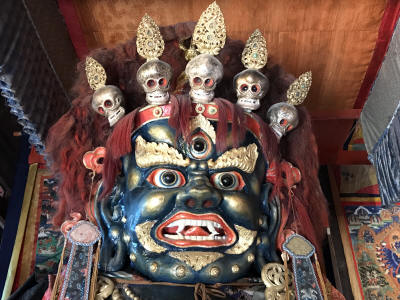 One of the zen protectors |
After looking through the different structures, we visited Lavrin Temple, the only working temple on the Monastery grounds. The monks, who ranged from small boys to venerable old men, were led by the Baasan Lama (the head Abbot) in their rhythmic chanting. Afterwards, we had a private session with the Baasan Lama, who (we found out later) is known in Mongolia as “the singing monk,” having a rich and sonorous voice. He seemed young to be the head of the temple, clearly much younger than many of the other monks, but once you spent a few minutes with him, you understood why. This was a guy who radiated peace and contentment, so centered and calm you knew he had figured it out, life, the universe, and everything, and the answer wasn’t 42. This was a guy who should be cast in a Marvel superhero movies as the head of a secret monk order with magical powers.

Dave wanted to ask if him if he could open a sparkly circle portal to the top of the Himalayas a la Dr. Strange but Alison recommended against it.
The Baasan Lama offered to lead us in meditation, and after some
instruction we did a simple chant together, three words hummed loudly,
then softly, then sub-vocalized. And even for Dave, who is such a
Doubting Thomas that he doubts there really was a real Doubting Thomas,
the effect was profoundly calming and centering. It was a very
moving experience.
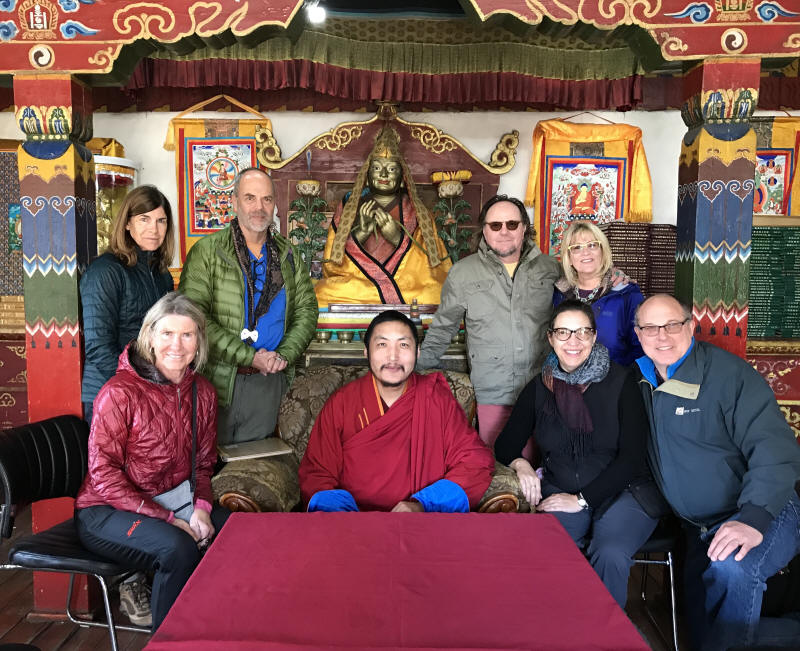
Afterwards, the Bassan Lama took us on a tour of the temple, including
the private contemplation room at the top of the Monastery, which is
normally only accessible by the monks.
 On the top of the temple |
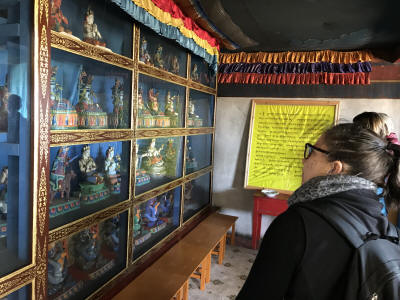 The private prayer room |
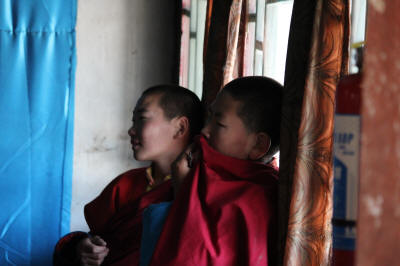 Young monks |
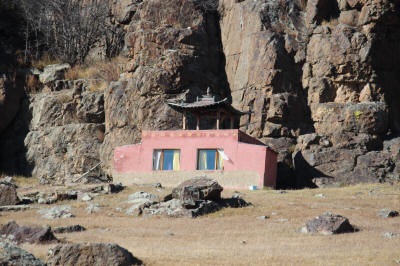 The Baasan Lama's private meditation site |
We did a short stop at a location where they are trying to excavate what little remains of the palace of the Khan, then headed back to the camp site.

Most of our group decided to go horseback riding once we got back to camp. We, however, chose to hike down the mountain to the river, or as far as we could get in an hour. That, as it turned out, was the bottom of the mountain; the river still had to be a good mile or two away. Going up was a lot more taxing than going down. But we were cranking away when down the side of the mountain came one of the SUVs looking for us.
 |
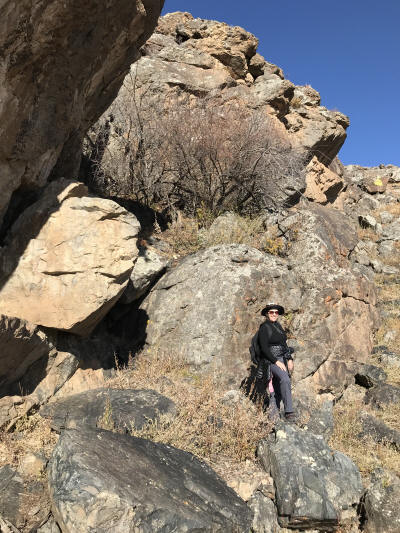 |
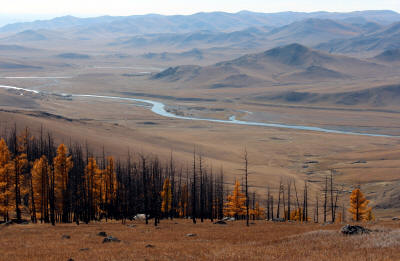 |
 |
There was a surprise waiting for us camp (and which we were holding up): two musicians and a contortionist, who put on a private performance just for our group. The two musicians were teachers at the local University; one made and played the traditional Mongolian flute. Zsolt from our group was also a flutist on two similar instruments, the Hungarian flute and the Native American flute. The two had a very cool little jam session together.
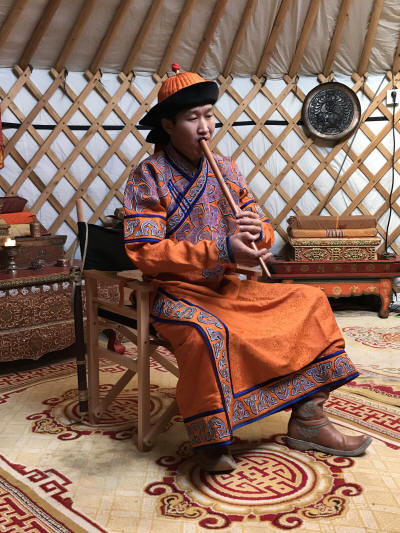 |
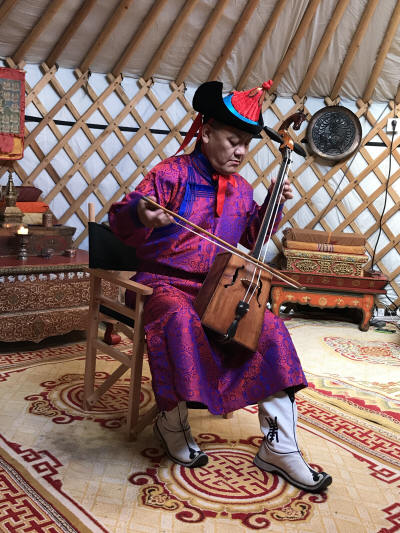 |
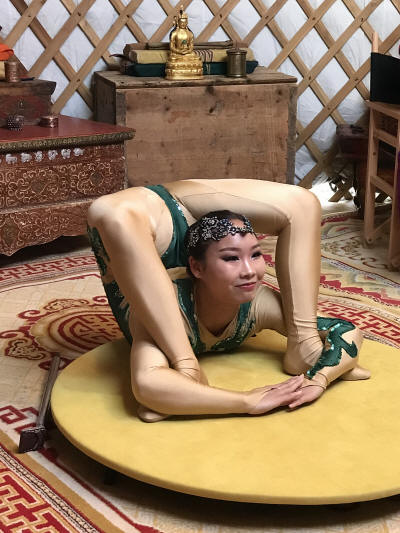 |
 |